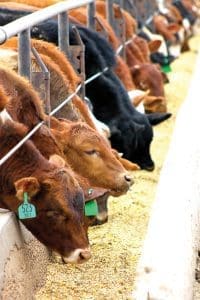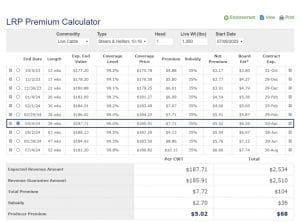By Larry Stalcup Contributing Editor

Fed cattle prices have seen a steady rise since markets tanked to under $100 per hundredweight (cwt.) in early 2020. They’ve recovered from the Tyson plant fire in Kansas and the early pandemic disruption of the cattle-harvest supply chain. Continued tight cattle supplies and strong consumer demand have seen prices explode past $180 and even $185 this summer. But as typically happens, what goes up will probably come down. Price volatility rules. And with the cost of finishing a steer at well over $2,000/head, price risk protection is likely indispensable.
“When you look at the equity tied up, the tremendous volatility in corn and feeder cattle prices, and tight cattle supplies and subsequent decrease in market-ready fat cattle, there could eventually be a pushback in demand,” says Mike Moroney, head of the beef margin management team at Commodity & Ingredient Hedging, LLC (CIH) in Chicago.
Moroney, a 23-year veteran of livestock and other commodity trading and producer consulting, says market strategies change and there is no one-size-fits-all plan for small or large operators. He notes there are numerous price risk management tools available to producers and feeders. They include Livestock Risk Protection (LRP) programs through the USDA Risk Management Service, CME Group futures and options, forward contracting in grid programs and other specialty marketing programs for all-natural, non-hormone or other cattle fed for specific demand markets.
Set a Floor With the Upside Open

Feeder cattle placed this summer will finish in early 2024. The April ’24 Live Cattle futures board prices were similar to the $170s and $180s in July. For fed cattle that will finish in April or May, Moroney recommends that cattle feeders consider using an LRP Live Cattle contract and/or put options to set a reasonable floor price and possibly have a window for upside price protection.
“For risk management, I like setting floors for cow-calf, stocker/backgrounder and feedyard guys,” Moroney says. “Even at these high price levels, I’d recommend maintaining some flexibility.
“Either use LRP or put options on the CME. Depending on risk tolerance/market outlook, you could go at-the-money puts, cheaper out-of-the-money puts, or even mix in some sold call options in Feeder Cattle or Live Cattle on the CME.”
For fall-delivered calves, he leans toward using the April LRP. Using early July LRP data, live cattle price protection with a $186 floor price was available at a reasonable level. “For about $5/cwt., or about $68/head, you could protect $2,534 in revenue [at the $186 floor],” Moroney says.
“If, and I mean if, a producer wanted to cheapen that up, he or she could pair that LRP with selling an April $202 call option on the CME. That would create a short obligation on the board at $202 for $2.50/cwt. The sale of that call option would limit opportunity above $202/cwt., but would cut the cost of the risk management in half.”
Moroney stresses that data for these projections was from July, and that LRP and options prices change daily or even by the minute. When taking out risk protection, make sure to use the current price projections to make final decisions, he says. The LRP-futures options strategy illustrates how the marketing tools complement each other, Moroney says, adding that producers and feeders can take advantage of the government’s Risk Management Agency (RMA) subsidies that can approach 35 percent for LRP programs.
Glynn Tonsor, Kansas State University (KSU) agricultural economics professor, agrees that risk management is encouraged to protect prices. “Each operator is encouraged to track their own financial situation to see how it compares with broader benchmarks,” he says, noting Kansas fed cattle close-out projections are published monthly on the KSU AgManager.info website. “They can assess points in time when it may make more sense to implement risk management strategies in their operation.”
The type of marketing program spelled out by Moroney could provide the price protection needed if the bullish market heads south. But in July, there were no signs of that happening. Fed cattle prices were from $178/cwt. in Southern Plains feedyards to $184 in northern yards. Their breakeven was in the neighborhood of $160 to $170. Profits were easily $150 to $250 or more per head.
According to The Ag Center (https://cattlereport.agcenter.com), cattle placed on feed in July had a projected breakeven price of near $180 or higher. Projected prices for cattle that will finish about six months later were near $185 or higher, based on live cattle futures prices in that range. Projected profits were $80 to $90/head.
In the July 3 Oklahoma State University Cow-Calf Corner newsletter, Derrell Peel, OSU Extension livestock marketing specialist, reacted to the June 1 feedlot inventory of 11.55 million head, “down 2.9 percent year over year. Feeder supplies and feedlot numbers will continue to decline as the reality of smaller cattle supplies builds. Increased heifer retention is likely to squeeze feeder supplies more sharply in the second half of the year. Producer expectations and remaining drought conditions will impact the timing of herd rebuilding efforts.”
Black Swans Can Take Flight
With three years of price increases, some people have backed off from buying price risk protection. “You see it,” Moroney says. “There’s a lot of risk management fatigue.”
But while herd rebuilding, tight supplies and strong demand point to stout prices – history indicates there’s a potential black swan hovering over the horizon. Think back. There were no signs of the beef price freeze set in the 1970s, the whole-herd dairy buyout in the late 1980s, the BSE steer that stole Christmas in 2003, or that the COVID-linked price crash would cause another wreck in 2020.
Moroney adds that during the drought years from 2011 to 2014, cattle numbers were tighter and prices increased. The $170/cwt. price was to the moon. “However, in 2015 and ’16, an adverse price risk presented itself,” he emphasizes, and price risk management helped many weather the storm. “And if prices continue to increase well into 2024, there’s a guess as to how long strong consumer and foreign demand for beef will remain this high.”
Of course, cow-calf, stocker and background operators also need price protection. Calf and yearling prices are in the $240 to near $300/cwt. range. Those powerful prices are helping make up for losses caused by the pandemic and drought. It might be prudent to set a floor price. Moroney cites a potential LRP feeder cattle strategy for 800-pound steers to be sold in November. In early July, the early-November LRP offering enabled producers to lock in about $245 for about $6/cwt., he says, “or $48/head to protect an 8-weight steer valued at almost $2,000.”
He adds that for cow-calf, stocker and backgrounders, he is “less-inclined to sell call options to cheapen strategies because feedyard capacity has increased so much over the past several years and competition for feeders is going to be fierce.”
Moroney concludes that producers and feeders should work closely with a marketing consultant and/or trader to determine which risk management program is best for their operation. “Everyone should consider that with tight cattle supplies, volatility increases. And volatility doesn’t go in just one direction.”







